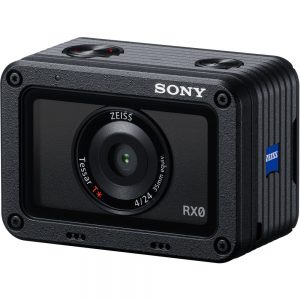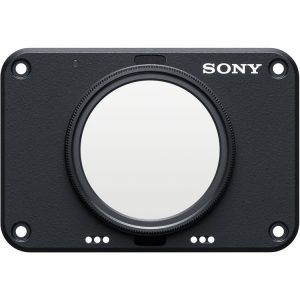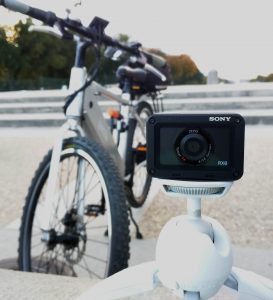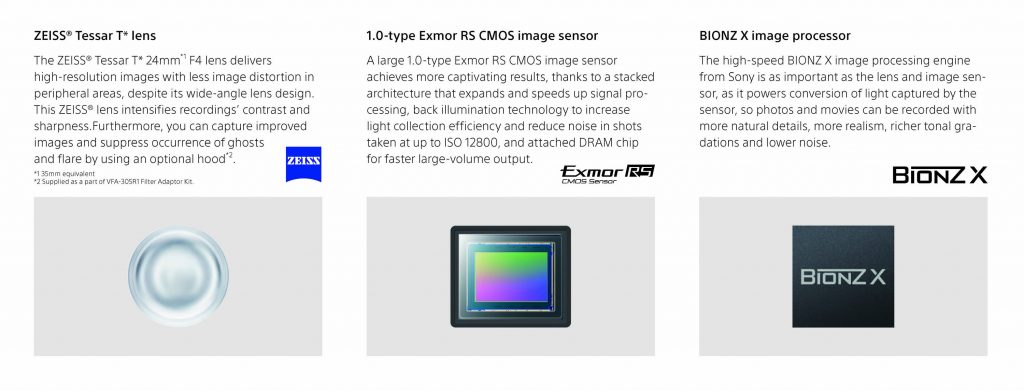Sony RX0

Price: $698
-
Technical Specs
-
Performance
-
Value for Money
There’s a durable adage that won’t ever go away, no matter what the future brings: “Your best camera is the one you’ve got with you.”
Buried in this week’s hysterical attention to Sony’s new a7R III cash cow — offering a tiny bump up from their already overpriced and mediocre a7R II — this sad little RX0 is having a hard time. So I thought I’d send the little thing some love with this thorough review, combined with test footage and comparisons, plus a guide to its menus. That video is embedded into this post from YouTube. (Sorry for the crap audio in the menu guide — never again!)
 Complementing what’s said in the video, this post adds a few still pictures for further study, and written reflections. But let’s start out quickly summarizing the pros and cons of the Sony RX0:
Complementing what’s said in the video, this post adds a few still pictures for further study, and written reflections. But let’s start out quickly summarizing the pros and cons of the Sony RX0:
PROS:
- Freaking small – as in, ice cube (and just as waterproof)
- 1-inch sensor at ~3x crop, with mediocre light sensitivity (but much smaller than even APS-C/Super 35mm)
- Better glass and narrower angle than any action cam by GoPro, etc. (say goodbye to fisheye)
- Microphone jack with manual audio level control
- S-Log2 S-Gamut picture profile
- Clean UHD-4k output without pixel-binning/downscaling artifacts
- $698 is cheap: reasonable folks can disagree, but Sony packed a lot of value into this tiny thing
CONS:
- 1080p-only internal downsampled recording, with severe aliasing
- Log profile requires minimum 1600 ISO gain, resulting in noisy image always at this sensor size
- Laughable $150 ND filter adapter option (for solving the fixed f/4.0 aperture problem)
- No optical (or even digital) image stabilization
Something I note in the video is that one key appeal of this product — like the affordable/modest/covert older siblings A6300 and A6500 — is its incorporation of a log picture profile. While Sony curiously leaves out its beleaguered S-Log3 here (lots of shooters actually prefer S-Log2 out of fear when seeing noise before REC.709 conversion), still, having S-Log2 in this tiny little box makes it a candidate for blending with footage from really any other professional cinema camera. That’s one of the great leveling virtues of log color: you stand a much better chance at being able to grade footage together from different cameras, especially when they’re from the same manufacturer. In the case of Sony, we’re talking about some of the worst color science in the industry, but what’s new? I make do with these compromises, and my a7S II has lately been my A-camera, until stubborn Sony finally puts that full-frame sensor into a proper cinema camera body without charging Venetian fortunes that are totally irrelevant to the vast majority of creators.
Problem is, like all other Sony cameras, S-Log2 starts at a minimum ISO gain of 1600. Bear in mind, 1600 on an a7S II looks a helluva lot different than on an RX0, because of the light-gathering capability of a full-frame sensor versus this tiny 1-inch sensor. Even though the RX0’s sensor size is a big selling point (and still bigger than legacy 2/3″ camcorder sensors), it’s laughably tiny compared to full-frame, or Super 35mm/APS-C, or even Micro Four Thirds…and that has the word “micro” in it! The result is, you get lots and lots of ugly digital noise at 1600 ISO. And since it only gets worse from there, S-Log on the RX0 is something of a catch-22.
I’ll still use only S-Log 2 in video mode, for matching the footage with other log shooters, but I anticipate lots of care exposing as best as possible, applying Denoiser plug-ins in post, and using ND filters.
 Or maybe not that last part. Because Sony (typically and hilariously) charges a greedy, offensive $150 for this simple doodad that provides one single function that should cost ten or twenty bucks. Yet you need ND, badly. My video tests were toward the end of the day, under partly cloudy skies, in order to use S-Log2 without blowing out highlights at ISO 1600. To repeat from the Cons, you can’t control “aperture” on this thing because there isn’t one: just a fixed equivalent to f/4.0. And for anyone serious about making movies, ultra-high shutter speeds, to compensate for that, are not an option (though that won’t stop the majority of RX0 shooters from posting horrible-looking clips with strobe-y motion, just like GoPros).
Or maybe not that last part. Because Sony (typically and hilariously) charges a greedy, offensive $150 for this simple doodad that provides one single function that should cost ten or twenty bucks. Yet you need ND, badly. My video tests were toward the end of the day, under partly cloudy skies, in order to use S-Log2 without blowing out highlights at ISO 1600. To repeat from the Cons, you can’t control “aperture” on this thing because there isn’t one: just a fixed equivalent to f/4.0. And for anyone serious about making movies, ultra-high shutter speeds, to compensate for that, are not an option (though that won’t stop the majority of RX0 shooters from posting horrible-looking clips with strobe-y motion, just like GoPros).
But let’s say that you land right into that comfy spot of ideal lighting conditions, and want to shoot video. Ultimately, this thing delivers surprisingly well. Internal 1080p is exceptionally good, with one caveat common to such radically downsampling sensors: lots of aliasing/moiré. You’ll see that in particular at 7:06 in my video (the link goes straight to that timecode), when you focus yourself on the lines of the wall in the subway station. In the old days — e.g., Canon 5D Mark II — the solution was to avoid any wide shots with little patterns and lines, so you could consider this a vintage shooting limitation of the RX0.
 Yet there’s one glorious way around the downsampling problem, and that is to … not downsample! The RX0’s HDMI port offers clean UHD-4k output without pixel binning, and in my video, you’ll see it looks spectacular. Add to that, you gain 4:2:2 color into any compatible recorder, such as the Atomos Shogun I used. I note that the usual self-proclaimed “pros” have comically whined about how nobody would possibly ever want to use the RX0 in tandem with a 4k recorder. Nonsense. I’m keeping this thing in my bag alongside bigger, more “professional” gear when I need another angle, either handing it over to a friend, or mounting it inconspicuously at a location otherwise inaccessible. I can run a long HDMI cable to the (extra) Shogun that I’m not using for anything else, or leave the Shogun hidden nearby. I can remotely control it all from my PlayMemories app on a tablet or smartphone, from my A-camera location. Besides all that, I can pocket the RX0 with me wherever I go, equipped to capture something unexpected with reasonably alright 1080p. So yeah, the Sony RX0 doesn’t somehow turn you into an amateur. It’s what you do with it that matters.
Yet there’s one glorious way around the downsampling problem, and that is to … not downsample! The RX0’s HDMI port offers clean UHD-4k output without pixel binning, and in my video, you’ll see it looks spectacular. Add to that, you gain 4:2:2 color into any compatible recorder, such as the Atomos Shogun I used. I note that the usual self-proclaimed “pros” have comically whined about how nobody would possibly ever want to use the RX0 in tandem with a 4k recorder. Nonsense. I’m keeping this thing in my bag alongside bigger, more “professional” gear when I need another angle, either handing it over to a friend, or mounting it inconspicuously at a location otherwise inaccessible. I can run a long HDMI cable to the (extra) Shogun that I’m not using for anything else, or leave the Shogun hidden nearby. I can remotely control it all from my PlayMemories app on a tablet or smartphone, from my A-camera location. Besides all that, I can pocket the RX0 with me wherever I go, equipped to capture something unexpected with reasonably alright 1080p. So yeah, the Sony RX0 doesn’t somehow turn you into an amateur. It’s what you do with it that matters.
Speaking of which, still photography: while the gap is narrowing between dedicated cameras and smartphone cameras, this thing will still take a better picture than the best smartphone camera today. Here is a gallery of samples, unaltered, straight from the camera (click to enlarge):
But Sony notoriously skimps on optical image stabilization, especially when they slap that Zeiss label onto products (which is really just buying a license to use the Zeiss tradename). So while plenty of light buys you a high shutter speed, when things get darker, it’s nearly impossible to get a clear shot as the shutter speed dives down to compensate (or you pump up the noise with ISO gain). Thus in the last of these five samples, the blur was basically unavoidable. But the word “spycam” comes to mind, and the rather audacious notion — perhaps true — that this is the best camera in the world at such a miniature cube size. Nothing else comes close. That’s something.
 What’s really going to save your video footage is proper stabilization, ultimately, while respecting the compromises of what you can shoot, and what you can’t. You’ll be avoiding aliasing when you compose your shots, you’ll be adjusting your shutter speed if you absolutely must (avoiding fast motion), and you’ll be locking this thing down on sticks. I spent ten bucks on this Manfrotto “Pocket Support” making sure I never have the excuse that I left my tripod at home: now it’s bolted 24/7 onto the RX0.
What’s really going to save your video footage is proper stabilization, ultimately, while respecting the compromises of what you can shoot, and what you can’t. You’ll be avoiding aliasing when you compose your shots, you’ll be adjusting your shutter speed if you absolutely must (avoiding fast motion), and you’ll be locking this thing down on sticks. I spent ten bucks on this Manfrotto “Pocket Support” making sure I never have the excuse that I left my tripod at home: now it’s bolted 24/7 onto the RX0.
Is this Blackmagic Pocket Cinema Camera-level revolutionary? Sorta! Certainly, this reminds me how long it’s been since Blackmagic changed the world that way, and credit to Sony for taking the risk. Highly recommended.
The Sony RX0 is available from Amazon at amzn.to/2zGU2KG, from Adorama at focuspull.in/sonyRX0 and from B&H at focuspull.in/sonyrx0 for $698.






